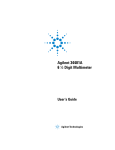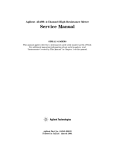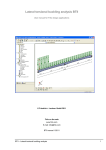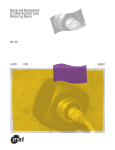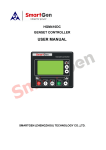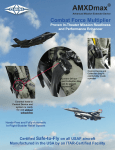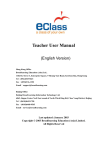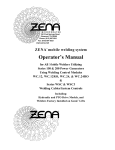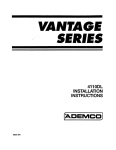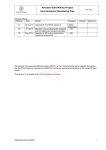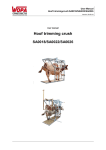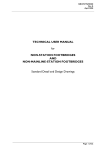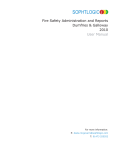Download TECHNICAL USER MANUAL ROCKBOLT
Transcript
NR/CIV/SD/TUM/590 Rev A July 2010 TECHNICAL USER MANUAL for ROCKBOLT CONSUMABLES AND TESTING Standard Detail and Design Drawings _________________________________________________________________________ NR/CIV/SD/TUM/590 Rev A July 2010 Summary The purpose of this document is to provide background information on Rockbolt Consumables and Testing to be used for Tunnel Renewals as part of the suite of Network Rail Standard Tunnel Repair Details. The aim is to utilise cost efficient rockbolting systems based on standard off the shelf rockbolting consumables and their compatible off the shelf standard drilling consumables. Issue record This technical user manual will be updated when necessary by distribution of a complete replacement. A vertical black line in the margin will mark amended or additional parts of revised pages. Revision Date Comments A July 2010 First Issue Disclaimer In issuing this document for its stated purpose, Network Rail makes no warranties, express or implied, that compliance with all or any documents it issues is sufficient on its own to ensure safe systems of work or operation. Users are reminded of their own duties under H&S legislation. Supply Copies of documents are available electronically, within Network Rail’s organisation. Hard copies of this document may be available to Network Rail staff on request to the relevant controlled publication distributer. Other organisations may obtain copies of the document from IHS (Technical Indexes Ltd) tel: 01344 328 039 Comments The applicability and content of this standard will be reviewed on a regular basis. Written comments on the accuracy and utility of this standard will be taken into account when assessing the need for a new issue of the standard; such comments should be sent to the Principal Policy and Standards Engineer (Civil Engineering) at 40 Melton Street, London NW1 2EE. _________________________________________________________________________ NR/CIV/SD/TUM/590 Rev A July 2010 CONTENTS Section Description Page 1 INTRODUCTION 01 2 RENEWAL DETAIL DESCRIPTION 01 2.1 Common usages for rockbolts 01 2.2 Useful Definitions 01 2.3 Rockbolt Material Types 03 2.4 Material Choice – Performance under Loading 04 2.5 Material Choice – Electrical Conductivity 04 2.6 Bond Mediums 04 2.7 Selection of Bond Medium 06 2.8 Mechanical Components 08 3 LIMITATIONS OF USE 10 3.1 Rockbolting and Voiding 10 3.2 Weak Tunnel Lining 13 3.3 Weak Rock Strata 13 4 DEFECTS TO BE REMEDIED 14 4.1 Introduction 14 4.2 Rock Reinforcement in Unlined Tunnels 14 4.3 Material Defect in Masonry Lined Tunnels 14 4.4 Structural Defect in Masonry Lined Tunnels 15 5 DESIGN PHILOSOPHY 15 5.1 Introduction 15 5.2 Rock Reinforcement in Unlined Tunnels 15 5.3 Material Defect in Masonry Lined Tunnels 15 5.4 Structural Defect in Masonry Lined Tunnels 16 6 INVESTIGATION AND TESTING 16 6.1 Introduction to SEPT 16 6.2 SEPT Historical Background 16 6.3 SEPT Testing – Other Information 17 7 HEALTH AND SAFETY 18 7.1 Collapse of Existing Lining 19 7.2 Rockbolt Failure during Testing 19 _________________________________________________________________________ NR/CIV/SD/TUM/590 Rev A July 2010 7.3 Considerations to adequate Ventilation 19 8 FURTHER GUIDANCE 19 8.1 Headroom and Gauge Clearance 19 8.2 Overhead Line Electrification 19 8.3 Installation 20 8.4 Definitions of Sub-Standard Installation 20 8.5 Overcoming Potential Problems 21 8.6 Quality Control 24 ANNEXE I Schedule of Standard Drawings 26 ANNEXE II List of References 26 ANNEXE III SEPT Testing Pro Forma 27 _________________________________________________________________________ NR/CIV/SD/TUM/590 Rev A July 2010 _________________________________________________________________________ 1 INTRODUCTION The purpose of this document is to provide background information on Rockbolt Consumables and Testing as used for Tunnel Renewals as part of the suite of Network Rail Standard Tunnel Repair Details as specified in the Standard Detail Drawings NR/CIV/SD/590 and NR/CIV/SD/591 (herein referred to as SD Drawings). The Standard Details aim is to ensure a cost efficient system based on the utilisation of standard, off the shelf rockbolting consumables & their compatible off the shelf standard drilling consumables. These systems have been developed to allow easy and practical application on site with high productivity and high system performance which relies on the application of simple on site quality controls. 2 RENEWAL DETAIL DESCRIPTION 2.1 Common usages for Rockbolts Rockbolts are a common element used in tunnels and are also applicable in shafts, cross passages, adits and portals. The system applies to the following applications of rockbolts:- 2.2 • Spotbolting • Pattern bolting • Pattern bolting with mesh • Pattern bolting with shotcrete Useful Definitions Definitions are given below for some of the common terms used through out this Technical User Manual, and featured on the SD Drawings. 2.2.1 Rockbolt System The combination of rockbolts, their associated mechanical components (i.e. end plates, nut, washer, couplers) and consumables (i.e. resins or grouts) is given the term; “Rockbolt System”. Rockbolt Systems should not be confused with Anchor Systems, Anchor Bolts, Ground Anchors or similar and the following distinction is made between these systems. _________________________________________________________________________ TUM – Rockbolt Consumables and Testing Page 1 of 27 NR/CIV/SD/TUM/590 NR/CIV/SD/TUM/590 Rev A July 2010 _________________________________________________________________________ For the purposes of this SDD and TUM “Rockbolts” are fully encapsulated throughout their installed length in resin or grout which provides a bonding medium between the rockbolt and the ground. Load is transferred through the bonding medium throughout the embedded length with less reliance on load transfer through the end plate assembly, although nominal tightening loads may be applied through the end plates during bolt installation where two speed resin systems are applied. In extreme cases where ground movement results in the dilation of the strata within the rockbolted length, end plates may also become loaded in service. Anchor Systems are not generally fully encapsulated in a bonding medium and, as the name suggests, rely on the anchorage and the end plate to tension the anchor for ground support. Large pre-stressing loads may be applied to these systems. 2.2.2 Short Encapsulation Pull Test - SEPT Short Encapsulation Pull Test or SEPT is the name given to the testing methodology for rockbolt systems. Further detail on the SEPT is given in Section 6 2.2.3 Bond Medium “Bond Medium” refers to the resin or grout that provides the bond between the rockbolt and the surrounding strata. Refer to Section 2.6 for further information on bond mediums. 2.2.4 Anchor Zone “Anchor Zone” is a term used with anchor systems or with rockbolt systems where a two speed bonding medium is used. For rockbolt systems the “Anchor Zone” refers to the initial length of the rockbolt in which the Fast Set Resin is utilised to provide an initial anchorage for bolt tensioning whilst the Slower Set Resin or grout cures. This allow for the rapid installation of rockbolt systems. Reference is also made to the anchor zone in the SEPT where a reduced bond length (i.e. a measured short encapsulation) is required for testing purposes. In construction rockbolts the length of the anchor zone can vary dependent upon performance requirements and capsule sizes. _________________________________________________________________________ TUM – Rockbolt Consumables and Testing Page 2 of 27 NR/CIV/SD/TUM/590 NR/CIV/SD/TUM/590 Rev A July 2010 _________________________________________________________________________ 2.2.5 Bolt Free Length The “Bolt Free Length” refers to the length of rockbolt that is not bonded to the surrounding rock. In SEPT tests this refers to the length of rockbolt between the encapsulated end anchor zone and the inside face of the loading nut. The dimension is indicated on SD Drawing NR/CIV/SD/590. 2.2.6 Bolt Diameter Rockbolts are typically produced with a continuously threaded or ribbed profile to improve bond performance. Where the Standard Detail Drawings refer to “Bolt Diameter” this should be taken as the “Outside Diameter” of the rockbolt, i.e. to include the threaded or ribbed diameter. Typically, the manufacturer’s stated classification of the rockbolt (i.e. 24mm Dia.) includes the thread / ribbed diameter in this measurement. NOTE FOR SEPT Testing : Both the outer diameter and the core diameter of profiled rockbolts need to be measured and recorded for SEPT testing, (see Section 6 for more details on this). 2.2.7 Scheme Designer “Scheme Designer” refers to the party responsible for specifying the detail to be used. The Scheme Designer may be a third party consultant or in some instances, a Network Rail representative. Input from the Scheme Designer is required for specifying the rockbolt system design parameters including rockbolt type, rockbolt length, rockbolt density and pattern, required bond stress, mesh specification or SCL specification and for matters such as mitigation actions for voiding or allowable bond performance criteria. 2.3 Rockbolt Material Types The rockbolts selected for use with this SD Design are made from corrosion resistant materials, typically Glass Reinforced Plastic (GRP), Galvanised Steel or Stainless Steel. They come in a range of diameters and lengths dependent upon the application in question and the required load capacities. _________________________________________________________________________ TUM – Rockbolt Consumables and Testing Page 3 of 27 NR/CIV/SD/TUM/590 NR/CIV/SD/TUM/590 Rev A July 2010 _________________________________________________________________________ 2.4 Material Choice – Performance under loading The choice of rockbolt type will depend on the nature of the applied loading and how the rockbolt is required to perform when subject to shear or tensile loading. 2.4.1 Shear Resistance Where resistance to shear forces is critical, steel rockbolts may provide a performance advantage over GRP rockbolts. 2.4.2 Tensile Strength Where mobilising the tensile strength of the rockbolt is critical either steel or GRP rockbolts may prove effective. However, GRP rockbolts may provide an advantage over steel bolts in terms of their lightweight nature (for manual handling), flexibility during insertion, and long term corrosion resistance. 2.5 Material Choice – Electrical Conductivity GRP rockbolts are suitable for applications in which electrical non-conductivity is a desired material characteristic such as for use in tunnels where OHLE is present. 2.6 Bond Mediums The strength of the rockbolts is mobilised through the use of a “bond medium” which allows load transfer (shear or tensile forces) between the rockbolt and the surrounding rock strata. The bond medium can comprise high strength, high stiffness resins, grouts or a combination of the two. The design is based on full encapsulation of the rockbolt using the selected bond medium or mediums as described below. _________________________________________________________________________ TUM – Rockbolt Consumables and Testing Page 4 of 27 NR/CIV/SD/TUM/590 NR/CIV/SD/TUM/590 Rev A July 2010 _________________________________________________________________________ 2.6.1 Two Speed Resin System For Two Speed Resin Systems, full encapsulation is provided through utilisation of a combination of resins with differing setting speeds, whereby an end anchor zone provides an initial bond using a Fast Set Resin and the remaining encapsulated length utilises a Slow Set Resin. With this system the Fast Set anchor zone provides initial support to the rockbolt whilst the slow set resin cures. The system was developed to allow rapid installation times for rockbolting when used in conjunction with torque breakout nuts, where the completed rockbolt and end assembly are installed and tightened in a one-pass operation. The system also allows nominal pre-tension to be applied to the rockbolt. Typical setting times for the fastest and slowest resin are 15 seconds for the fastest and 2 minutes or 10 minutes for the slowest. Resin systems rely on there being a relatively small annulus between the drilled hole and the inserted bolt, with a typical annulus size being between 2mm to 3.5mm by radius. 2.6.2 Grout Only Systems For Grout Systems, full encapsulation is achieved through the use of cementitious column grouting. Due to the increased set time, temporary support may be needed to support the rockbolt during the setting period. Two grout systems are commonly used. A pumped grout system requires a grouting and breather tube to ensure full encapsulation and quality of installation. With this system the grouting is carried out after the rockbolt or anchor has been installed (post grouting). Pumped systems require much larger diameter boreholes to accommodate the grout and breather tubes needed for installation and consequently the bond performance of these systems tends to be much lower than resin systems. An alternative system utilises Thixotropic Grout where the grout is tremmied into the hole before the rockbolt or anchor is inserted. Because grout and breather tubes are not required for the installation, borehole sizes can be much smaller than for pumped grout systems potentially giving better bond performance, though the holes still tend to be larger than the hole sizes required for resin systems. This system is much simpler and easier to apply than the pumped system but hole diameter is important, particularly when installing vertical rockbolts as the grout can fall under gravity if the hole diameter is too large. Grout suppliers should be consulted to determine appropriate system parameters. _________________________________________________________________________ TUM – Rockbolt Consumables and Testing Page 5 of 27 NR/CIV/SD/TUM/590 NR/CIV/SD/TUM/590 Rev A July 2010 _________________________________________________________________________ 2.6.3 Combined Resin and Grout Systems Combined Resign and Grout Systems utilise a Fast Set Resin in combination with a column grout system. The configuration is similar to the Two Speed Resin System, but the Slow Set Resin is replaced with cementitious grout. This system utilises the Fast Set performance of the resin to remove the need to provide temporary support to the rockbolt system whilst the grout sets. Thixotropic grout is commonly used for combined systems. The system requires the borehole to be drilled to two diameters, a smaller diameter for the resin bonded section and a larger diameter for the grouted section. Combination resin and grout systems were developed for use with longer rockbolt installations where the two speed resin systems become difficult to install and have been used successfully in installations up to 8m long using flexible stranded rockbolts. 2.7 Selection of Bond Medium The advantages and disadvantages between Resin and Grout Systems for key performance criteria are outlined below. 2.7.1 Set Time The primary advantage of the use of the two speed resin system or the combined resin and grout system is that these allow rapid installation times and provide a completed installation immediately the endplates are tightened. This can be of particular benefit where working time is restricted (i.e. during possessions). 2.7.2 Ease of Preparation Resin systems can offer ease of installation over grout systems. Resins are supplied in pre-prepared capsules which offer ease of transportation and handling. Resin capsules are factory prepared and so offer assurance and a high degree of quality control of the resin / catalyst mixture. Grouts require a degree of onsite preparation. Grout is supplied in bagged powder form and is mixed with water using _________________________________________________________________________ TUM – Rockbolt Consumables and Testing Page 6 of 27 NR/CIV/SD/TUM/590 NR/CIV/SD/TUM/590 Rev A July 2010 _________________________________________________________________________ site mixing machinery and apparatus. Rigorous quality control measures are required to ensure the correct water to solids ratio is observed at all times. Once prepared, grouts have to be used almost immediately (within hours) whilst resin capsules can be stored until ready for use. Resin capsule have a shelf life of between 3 to 6 months and users should ensure that capsules are in date before use. 2.7.3 Ease of Installation Insertion of resin capsules into drill holes is easier than grout insertion, especially in circumstances where rockbolts are installed at height, for example for the installation of bolts in the crown or haunches of a tunnel. 2.7.4 Cost Grout Systems can offer cost advantages over Resin Systems. It is recommended however that the Scheme Designer give due consideration to the performance advantages of Resin Systems as the benefits listed above may outweigh the higher cost. 2.7.5 Length / Depth of Installation For applications envisaged by this TUM, Rockbolts will typically be 2.0 metres to 6.0 metres in length. Increased lengths might be required to improve pull-out strengths by increasing encapsulation length, or by extending into a stronger horizon. The Scheme Designer should assess the loading performance required and select an appropriate length. Longer length bolts will have an increased installation time and cost over shorter lengths. The limitation on the use of resin-only systems is often the contractors’ ability to install long rockbolts into small annulus holes due to the inherent viscosity of the resin. The resistance offered by the resin and the friction from contact of the rockbolt with the borehole wall may defeat the thrust provided by some rockbolting rigs. In such cases either a higher performance rockbolting rig is required or the use of the combined resin and grout, or, grout only systems may be more suitable. Table 1 below indicates the typical rockbolt lengths applied with each bonding system. _________________________________________________________________________ TUM – Rockbolt Consumables and Testing Page 7 of 27 NR/CIV/SD/TUM/590 NR/CIV/SD/TUM/590 Rev A July 2010 _________________________________________________________________________ Rockbolt Bonding Medium Rockbolt Hole Length Up to 3m 3m to 4m ■ ■* 2 Speed Resin 4m to 6m Resin + Grout ■ ■ Grout Only ■ ■ >6m ■ Table 1 *Achieving full resin encapsulation for 2 speed resin rockbolts greater than 3m in length may be difficult. Site installation trials should be carried out to confirm that an acceptable degree of encapsulation can be achieved before construction rockbolting commences with this system. Where an acceptable degree of encapsulation cannot be achieved the alternative bonding methods should be considered for these rockbolt lengths For lengths greater than 3 metres installation trials may be required to ensure that rockbolts can be installed with the given rockbolting rig in accordance with standard installation procedure. For lengths greater than 4 meters resins should only be used for the end anchorages in order to ensure the rockbolts can be properly installed. This limitation can be exceeded if the Geotechnical Contractor is confident he has the equipment to do so, and SEPT Testing proves installation to be possible. The column grouting will use cementitious grouts. 2.8 Mechanical Components Below follows a summary of the mechanical components that are combined to form the “Rockbolt System”. The SD Drawings relate the components of drill, grout, resin and end plate sizes. SD Drawings NR/CIV/SD/550 - 554 show typical application in conjunction with fibre reinforced sprayed concrete linings. _________________________________________________________________________ TUM – Rockbolt Consumables and Testing Page 8 of 27 NR/CIV/SD/TUM/590 NR/CIV/SD/TUM/590 Rev A July 2010 _________________________________________________________________________ 2.8.1 Nuts, Plates and Washers Rockbolt end assemblies comprising deformable end plate, low friction washer, torque nut and spherical seat are commonly used components of rockbolts used for rock reinforcement. All of these components perform a specific duty and it is vital that all are properly applied in every rockbolting application. Deformable end plates are manufactured and calibrated to deform at preset tensile loads which are slightly lower than the ultimate tensile load of the rockbolt itself. This provides a visible indication that the rockbolt is taking a load that is approaching the breaking load of the rockbolt. Torque nuts serve two purposes. The design may require rockbolts to be pretensioned to a specified load and in such cases, provided the torque insert is broken out during tightening the torque nuts ensure the correct loads are applied. Torque nuts also provide a mechanism for rapid single pass rockbolt installation by allowing the resin capsules to be mixed during rockbolt insertion and then allow tightening of the endplates after the fastest resin has cured, without removing the rockbolting rig (i.e. single pass). Spherical Seats are dome shaped washers that allow rockbolts to be installed at inclined angles of incidence to the face of the rock or lining (i.e. non-perpendicular) whilst maintaining full load transfer through the end plate which is maintained flat against the lining or rock face. Low friction washers are important to reduce the frictional forces between the end assembly components during bolt insertion so as to maximise the energy from the rockbolting rig in overcoming the resistant forces generated in small annulus installations. 2.8.2 Spider End Plates For applications where the Rockbolts are used to provide support to a sprayed concrete lining, Spider End Plates can be used. These serve to prevent localised punching shear failure of the SCL at the rockbolt head and facilitate an effective _________________________________________________________________________ TUM – Rockbolt Consumables and Testing Page 9 of 27 NR/CIV/SD/TUM/590 NR/CIV/SD/TUM/590 Rev A July 2010 _________________________________________________________________________ connection between the sprayed concrete lining and the rockbolt. Refer to SD drawing NR/CIV/SD/590 and for typical rockbolt and end plate configurations. 2.8.3 Other Mechanical Components For longer rockbolt installations where the tunnel clearance width is shorter than the required length of the rockbolt it may be necessary for the designer to specify “Couple Bolts”. With these, threaded couplers are used to join the separate shorter lengths of rockbolt. The disadvantage of these systems is that the connections may be weaker than the rockbolt, hence reducing the tensile strength of the system, and the couplers are a slightly larger diameter. This can cause difficulties with insertion into the small diameter holes required for a small annulus installations. For the SEPT tests rockbolt extension bars may be used. These are generally used where it is not feasible to leave sufficient rockbolt out of the test hole for it to extend through the hydraulic hollow cylinder jack and the load nut. These may be preferred in cases where tests cannot be completed in a single possession, i.e. where test bolts are installed in one possession and then pull tested in the next, and where the test bolts cannot be left protruding into the tunnel between the possessions. 3 LIMITATIONS OF USE The following section provides information on key areas which may limit / restrict the use of rockbolt systems, or require an input from the Scheme Designer. 3.1 Rockbolting and Voiding 3.1.1 Introduction to Voiding In masonry lined tunnels, voiding can exist behind the tunnel lining. The voiding is created during construction of the tunnel, where the cross sectional area of the excavation is greater than that required to construct the masonry lining within; this is referred to as “over break”. In some instances this voiding may have been packed with fill material or bridged with construction features, such as brick pillars, in order to provide contact between the lining and the surrounding ground. Construction standards varied and the degree of voiding can vary dramatically from tunnel to tunnel. _________________________________________________________________________ TUM – Rockbolt Consumables and Testing Page 10 of 27 NR/CIV/SD/TUM/590 NR/CIV/SD/TUM/590 Rev A July 2010 _________________________________________________________________________ 3.1.2 Effect on the Tunnel Lining The presence of voiding can affect the ability of the masonry lining to carry load by allowing deformation of the arch to occur. Adequate support must be provided to the arch and sidewalls to prevent them from deflecting. In many instances the tunnel will have remained structurally adequate despite the existence of the voiding, but the testing and installation of rockbolts may subject the lining to forces which may lead to localised deformations and possible failures of the lining. The nature of the forces that the lining will be subject to will be dependent on the purpose of the rockbolts, and the Scheme Designer must assess each individual circumstance. 3.1.3 Identification of Voiding Information may be available in the Tunnel Management Strategy (TMS) for the tunnel that indicates the presence (or potential) for voiding, but it is rarely possible to identify voiding by visual inspection without recourse to intrusive investigations. Drill holes (for rockbolt installation) should be inspected for voiding, using a crack detector or endoscope device. It is critical to gauge the approximate size of the voiding. It may be necessary to undertake further intrusive investigations using large diameter core holes (150mm dia) or similar to provide a more accurate assessment. 3.1.4 Mitigation Actions Where voids are detected, the Scheme Designer will advise the Geotechnical Contractor on the mitigation actions required. Where the lining is to be subject to loading, either through SEPT Testing (where the Hydraulic Pull Rig is braced against the lining) or through high torque loading of rockbolt end plates the following mitigation actions can be applied. • Voids should be pre-filled prior to testing using an expanding foam or grout. The Scheme Designer will be required to specify the most appropriate method based on the size of the void and individual site circumstances. It should be noted that the filling material must have sufficient compressive strength and adequate stiffness to withstand the applied loads and to minimise deflection. The curing times of filling materials should be taken into consideration. The presence of _________________________________________________________________________ TUM – Rockbolt Consumables and Testing Page 11 of 27 NR/CIV/SD/TUM/590 NR/CIV/SD/TUM/590 Rev A July 2010 _________________________________________________________________________ voiding should be identified and dealt with at an earlier stage so as to prevent the circumstance occurring whereby testing is delayed due to waiting for fill material to cure. • If the masonry tunnel lining will not be subject to excessive loading then voids may be left unfilled. This would apply where rockbolt end plates will not be subject to high torque loads. For undertaking SEPT, a specialist rig (stressing stool) can be utilised that will load the rock strata rather than the tunnel lining, by using braces that are drilled through the lining of the tunnel and load the rock strata behind. Installation using such a rig is time consuming due to the requirement of drilling multiple holes. • For construction rockbolts the designer should take into consideration the effect of voiding on the overall bonded length, i.e. in areas of deep voids longer rockbolts will be required to achieve the same bonded length.. 3.1.5 Monitoring • In circumstances where it has not been confirmed that there are no voids behind the lining, the lining should be monitored for deflection during SEPT testing or during the installation of construction rockbolts. • When undertaking SEPT testing or when installing construction rockbolts where end loads are to be applied, the lining should be monitored for deflection using a needle gauge or similar. The monitoring point should be within 0.5 metres of the rockbolt test point. • SEPT tests should be stopped should lining deflection exceed the bolt end displacement. Should this occur the load should be released gradually until the lining is unloaded. • Construction rockbolt installations should cease if the monitoring indicates that the lining is deflecting as a result of the rockbolt installation. _________________________________________________________________________ TUM – Rockbolt Consumables and Testing Page 12 of 27 NR/CIV/SD/TUM/590 NR/CIV/SD/TUM/590 Rev A July 2010 _________________________________________________________________________ • Testing or installation should also cease if any evidence of cracking should occur. The supervising Engineer should carry out an assessment of any damage/excessive deformation in case further actions are required. • Gauges used to record lining displacement should read to the same accuracy as those used to record bolt end displacement during the SEPT test (i.e. to an accuracy of 0.01mm). 3.2 Weak Tunnel Lining Much the same guidance for dealing with voiding can be applied to the testing and installing of rockbolts in masonry tunnel linings which have weakened due to material deterioration. The Scheme Designer should carry out an assessment of whether the lining will be subject to excessive loading. Weakened linings can be stitched and grouted in accordance with Network Rail Standard Detail NR/CIV/SD/525 - Tunnel Lining Cross Pinning and Grouting prior to loading. The lining should be monitored during testing and installation in accordance with the guidelines outlined in Section 3.1.5 3.3 Weak Rock Strata During SEPT testing in some weak rock the bond of the short encapsulated length may be defeated at relatively low loads where the 300mm bond length is adopted. This can give rise to a shortage of the detailed data required for bond strength and bond stiffness analysis. To combat this two bond lengths are to be adopted as part of a standard suite of pull tests, 300mm and 450mm (see SD Drawing NR/CV/SD/591 for details of the standard suite of tests). NOTE : For the 450mm bond tests in good quality rock the UTS of the rockbolt may be reached before bond failure occurs. In addition, to ensure that sufficiently detailed data is obtained during pull testing in weak strata the frequency of the load/displacement readings should be increased so that more readings are obtained per unit of applied loading than at higher loads. It is suggested that a minimum of 5 readings per tonne load (or equivalent) should be obtained at lower loads. This frequency can be relaxed to recording load & displacement at 10kN (or equivalent) increments when it is evident that satisfactory test data will be obtained by doing so. The above guidance should be read in conjunction with the notes provided on SD Drawing NR/CV/SD/591 for SEPT testing of rockbolts. _________________________________________________________________________ TUM – Rockbolt Consumables and Testing Page 13 of 27 NR/CIV/SD/TUM/590 NR/CIV/SD/TUM/590 Rev A July 2010 _________________________________________________________________________ 4 DEFECTS TO BE REMEDIED 4.1 Introduction Repairs may adopt rockbolts only (either as singular spotbolts, or as part of a pattern of rockbolts) or may be used as components of a composite repair in conjunction with either mesh or sprayed concrete. Common tunnel defects to which rockbolts may be applied are detailed below: 4.2 Rock Reinforcement in Unlined Tunnels Rockbolts can be used to reinforce rock strata and prevent rock fall and collapse. They are suitable for use in a wide range of applications where weak or exposed rock strata requires reinforcement and are not limited to unlined tunnels. Dependent upon the individual circumstances, the rockbolts may be used singularly for local reinforcement (e.g. individual rock block support), or in patterns to reinforce strata over a larger area. Pattern Rockbolts may be applied with surface confining mesh, with rock netting or with sprayed concrete to offer composite solutions. Guidance on geotechnical assessement of rock faces and design of rock reinforcement is outside the scope of this TUM and specialist advice should be sought. However the guidance material provided on rockbolt system selection and testing is valid. 4.3 Material Defect in Masonry Lined Tunnels As part of the suite of standard design details for tunnel renewals, rockbolts can be used as a component to provide support to relining works. In such cases rockbolts are installed through the lining and into the surrounding rock. Dependent upon the individual requirements, rockbolts may be used to provide restraint to steel mesh for a temporary repair, or support to a sprayed concrete lining for a permanent repair. Further information on both temporary and permanent repairs to remedy material defect is covered under the relevant SD Designs (listed below), however the guidance given in this TUM is relevant in the selection and testing of rockbolt systems as a component of these repairs. • NR/CIV/TUM/550 - Sprayed Concrete Lining Renewal Detail For Masonry Arch Tunnels • NR/CIV/TUM/580 - Emergency Temporary Mesh Repair _________________________________________________________________________ TUM – Rockbolt Consumables and Testing Page 14 of 27 NR/CIV/SD/TUM/590 NR/CIV/SD/TUM/590 Rev A July 2010 _________________________________________________________________________ 4.4 Structural Defect in Masonry Lined Tunnels Rockbolts can also be used to provide restraint to the masonry lining of tunnels in conjunction with steel strapping where cracking of the lining is occurring. This application requires detailed assessment on the causes of the failure, which is outside the scope of this TUM and the standard suite of tunnel renewal SD Designs, however, the guidance on the selection and testing of rockbolt systems is relevant as a component of the repair. 5 DESIGN PHILOSOPHY 5.1 Introduction Rockbolt systems are a structural element that can be utilised to act in differing ways dependent upon the nature of the application. It will be the role of the Scheme Designer to assess the nature of the applied loading and select a suitable rockbolt system with the required shear or tensile strength for a particular application. It is the purpose of this TUM to provide guidance on the application of rockbolt systems as a component of these repairs, rather than provide guidance on the repair itself, for which guidance in the relevant associated TUM should be sought. Guidance is given below on the critical performance criteria for a range of typical applications. 5.2 Rock Reinforcement in Unlined Tunnels Rockbolts used to provide “reinforcement” to rock strata (i.e. when used in unlined tunnels to prevent rock fall) transfer load from the strata via the bonding medium to mobilise the tensile and shear strength of the rockbolt. In such applications the resistance of the rockbolt to the applied shear and tensile forces should be analysed. 5.3 Material Defect in Masonry Lined Tunnels Where rockbolts are used to provide support to sprayed concrete tunnel linings, tensile load derived from the weight of the spayed concrete lining carried by the rockbolts is transferred from the rockbolt into the strata via the bonding medium. In such applications the resistance of the rockbolts to the applied tensile forces should be analysed. _________________________________________________________________________ TUM – Rockbolt Consumables and Testing Page 15 of 27 NR/CIV/SD/TUM/590 NR/CIV/SD/TUM/590 Rev A July 2010 _________________________________________________________________________ 5.4 Structural Defect in Masonry Lined Tunnels Where rockbolts are used to provide support and restraint to masonry lined tunnels, the rockbolts may be subject to both shear and tensile forces and the magnitudes of the combination of both forces should be assessed. 6 INVESTIGATION AND TESTING 6.1 Introduction to SEPT The performance of the rockbolts, and the allowable design loads vary dependent on the nature of the rock horizon in which the rockbolts are to be installed. For this reason, it is vital that insitu testing is carried out prior to the detailed design stage in order to ascertain the rockbolt design loadings. Rockbolt drilling and testing methodology should be in accordance with the “Short Encapsulation Test Method” as detailed in SD Drawing NR/CIV/SD/591. The full procedure for testing is given on the drawings and will not be reiterated here. The installation procedure of the test bolts including the bolting consumables used should accurately represent the systems and procedures to be used for the installation of the permanent works. The minimum test requirements are outlined in the SD Drawing. 6.2 SEPT – Historical Background The testing methods described in the Network Rail SD Design for rockbolting in tunnels are different to those described in the British Standards for rock anchors which are commonly used by Civil Engineering designers for ground anchor project design and control. The British Standard, BS 8081:1989 and its replacement BS EN 1537:2000, describe tests that were originally conceived as part of a ground anchor test regime where anchors consist of a fixed anchor length and a free anchor length, and not for full column bonded rockbolts. The tests described in BS EN 1537 do not provide the load / deformation characteristics of a rockbolt subjected to loading across rock joints, a situation for which the rockbolt systems specified in the NR SD Design are designed and utilised. Therefore, alternative test methods are required that are appropriate to the type of rockbolt design specified in the SD Design. The test methods described in this SD Design are aimed at providing data on the bond _________________________________________________________________________ TUM – Rockbolt Consumables and Testing Page 16 of 27 NR/CIV/SD/TUM/590 NR/CIV/SD/TUM/590 Rev A July 2010 _________________________________________________________________________ performance of the rockbolt system. They are destructive tests that measure the ultimate bond performance right up to bond failure, thus providing a full understanding of the ultimate performance capabilities of the rockbolt system. These tests are standard in the UK mining industry and the test regime is specified in the publication Guidance on the use of rockbolts to support roadways in coal mines (1996). Similar methods are also advocated in many rock mechanics journals and text and are accepted within the international rock mechanics community as best practice. Independent professional opinion has been sought in the development of these test methods for Network Rail tunnel works and this can be found in a test report prepared by Graham Daws Associates for Weldgrip Geotechnical for work carried out on the LNW North Wales Tunnels project 2007. As a further note, BS EN 1537:2000 is considered “Complimentary and Non-Contradictory” under the new Eurocode System and thus can be used for design purposes without contravening BS EN 1997 Eurocode 7 : Geotechnical Design. 6.3 SEPT Testing – Other Information Guidance is given on SD Drawing NR/CIV/SD/591 in the undertaking of SEPT testing for rockbolt systems. The Scheme Designer should ensure that they are familiar with the process and requirements of the test procedure prior to site works commencing. The guidance given on the drawing should be adhered to so as to ensure that testing is carried out correctly, safely, and provides satisfactory results. Further background information is given on some of the requirements for the test is given below. Reference should also be made to Section 3.1 in this document regarding dealing with the presence of voiding. 6.3.1 Location Test locations should be accurately recorded using a readily identifiable reference such as Tunnel Chainage / Marker Plates +/- distances in metres. Record should also be made of which side of the line/tunnel the test is located (Up/Dn) as well as an approximate height above track level of each test. _________________________________________________________________________ TUM – Rockbolt Consumables and Testing Page 17 of 27 NR/CIV/SD/TUM/590 NR/CIV/SD/TUM/590 Rev A July 2010 _________________________________________________________________________ 6.3.2 Allowances for Sidewall Testing Only Where the rock strata surrounding the envelope of the tunnel is variable, a suite of tests should be carried out in each of the rock horizons present. This may require tests being carried out in the sidewalls and in the crown of the tunnel, however, the requirement for testing in the crown may be omitted such that testing defaults to the sidewall only, providing it is confirmed that the geology indicates that different rock types are not present around the tunnel within the rockbolting horizon. Installing rockbolts at height within the crown and haunches presents a significant logistical challenge requiring specialist access and support equipment. This may be unnecessary in certain circumstances and by omitting the crown tests significant cost savings may be realised. 6.3.3 Rockbolt Diameter and Resin Capsule Re-Sizing During SEPT testing it is essential that both the outer diameter and the core diameter of profiled rockbolts are measured accurately using vernier callipers. In addition the type of ribbed or threaded profile of the rockbolt should be recorded. Given the borehole dimensions (measured by borehole micrometer for each test hole) and the resin capsule diameter (also measured using callipers) it is possible to determine the length to which resin capsules need to be re-sized in order to give the correct bond length once the test bolt has been installed through it. The formula for calculating resin capsule length is given in Section 2.7 of the notes on SD Drawing NR/CV/SD/591. 7 HEALTH AND SAFETY In accordance with the CDM Regulations 2007, significant risks associated with the design are detailed below. Risks which a competent contractor should be aware of (e.g. working at height) are omitted. The list is not exhaustive, and not necessarily applicable to all circumstances. _________________________________________________________________________ TUM – Rockbolt Consumables and Testing Page 18 of 27 NR/CIV/SD/TUM/590 NR/CIV/SD/TUM/590 Rev A July 2010 _________________________________________________________________________ 7.1 Collapse of Existing Lining or Damage to the Lining Care must be taken to prevent collapse or damage to the existing lining during testing of rockbolts and/or in the use of RRV’s and equipment within the tunnel. Mitigation measures to prevent lining collapse are detailed in the SD Drawings. 7.2 Rockbolt Failure during testing The rockbolts are tested either to failure, or an agreed maximum load. Testing should be in accordance with established practice (SEPT) and carried out by suitably qualified and experienced personnel. Failure of rockbolts under tensile loading can be sudden and all personnel should fully understand the potential failure modes and associated risks and should ensure they adopt safe personal positioning at all times. 7.3 Consideration to adequate ventilation Dust from coring works and exhaust fumes from plant and machinery can result in a poor atmosphere within the tunnel. Steps should be taken to minimise the creation of dust/fumes where possible and means to provide adequate ventilation if required. Where appropriate dust masks and PPE should be deployed by all personnel in the vicinity of the test site and in areas of poor atmosphere. 8 FURTHER GUIDANCE 8.1 Headroom and Gauge Clearances Existing rail traffic gauge clearances are to be maintained at all times. After testing all test bolts are to be cropped flush with the rock or lining after the test has been completed such that there are no protrusions that may impact upon clearances. 8.2 Overhead Line Electrification Care must be taken not to damage overhead line electrification during installation and testing. Particular care should be taken when operating RRV’s, drill rigs and associated equipment. Test locations should be selected in order to minimise any interface with the _________________________________________________________________________ TUM – Rockbolt Consumables and Testing Page 19 of 27 NR/CIV/SD/TUM/590 NR/CIV/SD/TUM/590 Rev A July 2010 _________________________________________________________________________ overhead lines, for example testing in the haunch as opposed to the crown area where possible in OHLE areas. It is recommended that GRP bolts are used in tunnels with OHLE. Steel ancillary components should similarly be avoided. Electrical isolations should be in place prior to and during the works. 8.3 Installation Installation of rockbolts should be in accordance with the manufactures guidelines and undertaken by a competent Contractor. Typical installation procedures are shown on SD Drawing NR/CIV/SD/590. Only rockbolts for which there have been SEPTs carried out shall be installed. If there are any variations in sizes, dimensions or material types or material combinations to those specified in the design and for which SEPT tests have been carried out, further SEPT testing of these will be required and their adequacy in terms of performance confirmed before such systems can be adopted. 8.4 Definitions of Sub-Standard Installation During construction, where an individual rockbolt fails to meet the Scheme Designer’s installation specification, the Contractor should install an additional rockbolt of the same specification in close proximity to the sub-standard bolt, but not closer than 0.3m. The following is classified as a sub-standard rockbolt installation: • Reduced Resin Bond Length • Torque Nut Installation Error (i.e. Nut failed to break) • Loose End Plates • Missing or faulty components • Lack of exposed thread following installation. It is good practice to ensure that a minimum of 25mm of rockbolt thread protrudes beyond the load nut after installation. • Excessive exposed thread. Too much exposed thread is an indication that the rockbolt may not be properly installed. Rockbolts with more than 75mm of exposed thread should be considered sub-standard. Where a significant number of installations are deemed to be sub-standard, and or where additional installed bolts are also sub-standard the Scheme Designer should be consulted as the loading capacities of the renewal works may be compromised. _________________________________________________________________________ TUM – Rockbolt Consumables and Testing Page 20 of 27 NR/CIV/SD/TUM/590 NR/CIV/SD/TUM/590 Rev A July 2010 _________________________________________________________________________ 8.5 Overcoming Potential Problems The following section provides background information on potential problems that may arise during the testing and installation and how they may be solved or mitigated. Critical areas such as dealing with voiding are covered in Section 3.1 of this document. SEPT Testing should highlight any difficulties concerned with the drilling and the installation of rockbolts and will allow the performance of varying rockbolt systems and drilling methodologies to be assessed. SEPT Testing will also provide an indicator on likely install time per bolt, allowing for an assessment to be made on what is achievable per shift when the permanent works are installed. 8.5.1 Hard Drilling During SEPT Testing, the opportunity should be taken to trial the performance of drilling consumables and ensure selection of the optimum drill type for installation of the permanent works. “Drill Type” includes the drill bit size and type, drill rod size and type, drill machine and the hole debris clearance system used. Geological information on the surrounding strata may be contained in the Tunnel Management Strategy (TMS) Document, or can be identified using Geological Mapping. Based on preliminary geological information, a competent Geotechnical Contractor will be able to select a range of drill types based on previous experience in similar strata so as to narrow the field of choice. 8.5.2 Rockbolt Insertion Issues In some instances rockbolts may prove to be difficult to insert into the drilled hole. This may be down to several reasons which are briefly outlined below. • Restrictive Annulus Size – For optimum bond performance when using resins, annulus size should be kept to a minimum. However, where the annulus is too small, longer length rockbolts may prove difficult to insert due to clearance restrictions and a resistance to bolt insertion offered by the inherently high viscosity of the resin. Where this occurs the first step is to confirm that the hole size is to specification. This can be done using a borehole micrometer. The next step is to check that debris from the drilling process is being properly _________________________________________________________________________ TUM – Rockbolt Consumables and Testing Page 21 of 27 NR/CIV/SD/TUM/590 NR/CIV/SD/TUM/590 Rev A July 2010 _________________________________________________________________________ flushed from the borehole. Testing the drill machine flushing pressure and repeating hole flushing prior to bolt insertion would confirm this. Next the machine thrust should be checked to ensure it is functioning effectively and is in fact delivering sufficient thrust to insert the bolt. Where the hole size is correct and hole flushing and machine thrust prove acceptable but the problem still occurs, the Scheme Designer should consider performance requirements and if the annulus size can be increased to allow easier installation of the bolt, or whether opting for one of the alternative bonding mediums (resin and grout or grout only) may be required. SD Drawing NR/CIV/SD/590 provides nominal and maximum annulus sizes for a range of bolt diameters. • Worn Drill Bits or Wrong Selection – Drilled holes may become undersized if drilling consumables (drill bits and drill rods) become worn. This may lead to difficulty when inserting the rockbolt. Regularly checking the hole size using a borehole micrometer will identify if this is an issue. Similarly inserting a rockbolt manually and without resin to check for resistance may also confirm the problem. Wrongly selected drill bit type may also result in tight holes. Alternative drill bit types and drill rod types should be tried to find the optimum solution. The Scheme Designer should ensure that the Geotechnical Contractor has carried out an assessment to allow selection of the correct drill type, and equipment is in good condition. • Damage to Resin Capsules – The drill hole may be rifled but should be relatively smooth to prevent snagging for the ease of insertion and prevention of damage to resin capsules whilst being inserted. Resin capsules should also be inserted using resin insertion tubes (or launch tubes) made specifically for the purpose. In vertical or inclined holes, retaining caps are also required to hold the resin capsules in place in the hole prior to rockbolt insertion. • Non Linear Boreholes – Rockbolts have limited ability to flex and will snag on the sides of the drill hole during insertion if the hole is not drilled straight. As _________________________________________________________________________ TUM – Rockbolt Consumables and Testing Page 22 of 27 NR/CIV/SD/TUM/590 NR/CIV/SD/TUM/590 Rev A July 2010 _________________________________________________________________________ with the above, a competent Geotechnical Contractor will be able to select the optimum drill type and ensure holes are drilled correctly. Where non-linear boreholes are found to be unavoidable larger holes and/or the alternative bonding systems or rockbolt types should be considered by the Scheme Designer. In this case further SEPT tests will be required. • Lack of Machine Thrust – Dependent upon the length of encapsulation and the bond medium, the machine might not have sufficient strength to insert the rockbolt to the back of the borehole. This may be particular applicable to longer full column resin bonded rockbolts installed in small annulus holes. In these instances a higher thrust machine may be required. Where this is not possible the Scheme Designer should assess the performance requirements and possibility of either reducing encapsulation length for ease of installation or increasing hole diameter slightly. The latter would require further SEPT tests to confirm bond performance at the greater hole size. • Equipment Reliability The strict time constraints placed on operators working within track possessions and the difficulty in obtaining track access possession means that any machinery failure or similar may have a significant impact on job progress and project costs. A competent Geotechnical Contractor will typically ensure that they have back-up equipment in the event of a problem. The additional cost of allowing for extra plant can be offset by the huge costs if works should overrun, or additional possessions required. NOTE : It is strongly recommended that Scheme Designers specify that full installation trials be carried out before the scheme design is completed and that the type of issues described above are identified and overcome before the SEPT testing is commenced. NB: Despite the array of difficulties that may be encountered (as described above) every effort should be made to avoid reducing bond length or increasing hole diameter above the Scheme Design Specification as this will compromise bond performance. Wherever such changes are made this should only be with agreement from the Scheme Designer and for every change to specification further SEPT tests will be required. _________________________________________________________________________ TUM – Rockbolt Consumables and Testing Page 23 of 27 NR/CIV/SD/TUM/590 NR/CIV/SD/TUM/590 Rev A July 2010 _________________________________________________________________________ 8.6 Quality Control and Curing Times 8.6.1 Resin Quality Control and Curing Times Rockbolt resins have been developed for use in the mining industry where a rapid cure is a desirable characteristic. The temperatures within railway tunnels typically remain at a constant 10°C to 12°C throughout the year which is within the allowable operating temperature for most resins. Premature curing of resins is therefore unlikely to be an issue unless the resin condition has been affected in storage or in transit or if the resin is out of date. Resin that has been affect by heat during storage may be a source of premature curing. 8.6.2 Grout Quality Control and Curing Times • Grout performance can be assessed during SEPT Testing. The Contractor must ensure that the boreholes are fully flushed and cleaned so that the design performance is achieved. • The grout forms an integral part of the rockbolt system and the Supervising Engineer should ensure that it is prepared correctly with the correct mix proportions (e.g. Water : Solid Ratio) in accordance with the manufacturers’ recommendations. If difficulties in pumping are encountered, the mix design should not be altered without the approval of the Engineer. Grouts should always be placed as soon as possible following preparation. • The curing times and performance of the grout will be affected if site temperatures are approaching freezing. Although temperatures within a tunnel are typically a consistent 10°C to 12°C, certain wind speeds and directions can result in below freezing temperatures occurring. Grouts must not be exposed to temperatures below 2°C during preparation, placing or curing. Grouts must not be allowed to come into contact with surfaces or materials that are at a temperature of below 2°C. _________________________________________________________________________ TUM – Rockbolt Consumables and Testing Page 24 of 27 NR/CIV/SD/TUM/590 NR/CIV/SD/TUM/590 Rev A July 2010 _________________________________________________________________________ • Grouts must not be placed in the presence of running water. If the borehole is acting as a drainage channel grout must not be installed until measures have been taken to stem or drain the flow. • Rockbolts may be installed and then tested at a later date with the tunnel being open to train movements between shifts. In this case bolts must either be held in place by temporary supports or the grout must have sufficient curing performance to ensure a strength of 5 N/mm2 is reached prior to the line reopening. This must be confirmed by testing. _________________________________________________________________________ TUM – Rockbolt Consumables and Testing Page 25 of 27 NR/CIV/SD/TUM/590 NR/CIV/SD/TUM/590 Rev A July 2010 _________________________________________________________________________ ANNEXE I SCHEDULE OF STANDARD DRAWINGS Drawing Description NR/CIV/SD/590 Rockbolt Consumables Standard Details NR/CIV/SD/591 Standard Procedure for Performance Testing of Rockbolts using SEPT ANNEXE II LIST OF REFERENCES Network Rail NR/CIV/SD/525 Tunnel Lining Cross Pinning and Grouting NR/CIV/SD/550 Sprayed Concrete Lining Renewal Overspray NR/CIV/SD/551 Sprayed Concrete Lining Renewal Overspray Haunch Breakout NR/CIV/SD/552 Sprayed Concrete Lining Renewal Overspray Upper Haunch Breakout NR/CIV/SD/553 Sprayed Concrete Lining Renewal Crown Breakout NR/CIV/SD/554 Sprayed Concrete Lining Renewal Sidewall Breakout NR/CIV/SD/555 Sprayed Concrete Lining Renewal Miscellaneous Details NR/CIV/SD/580 Emergency Temporary Mesh Repair Eurocode BS EN 1990 Eurocode 0 - Basis of structural design BS EN 1991 Eurocode 1 – Actions on Structures BS EN 1991 Eurocode 2 – Design of Concrete Structures BS EN 1991 Eurocode 3 – Design of Steel Structures BS EN 1991 Eurocode 6 – Design of Masonry Structures BS EN 1997 Eurocode 7 – Geotechnical Design BSI (Historic and Complimentary) BS 8081:1989 Code of practice for ground anchorages BS EN 1537: 2000 Execution of special geotechnical work. Ground anchors Other HSE Guidance on the use of rockbolts to support roadways in coal mines (1996). Graham Daws Ltd Report prepared for Weldgrip Geotechnical for testing work carried out on the LNW North Wales Tunnels Project (2007). _________________________________________________________________________ TUM – Rockbolt Consumables and Testing Page 26 of 27 NR/CIV/SD/TUM/590 NR/CIV/SD/TUM/590 Rev A July 2010 _________________________________________________________________________ ANNEXE III SEPT TESTING PRO FORMA _________________________________________________________________________ TUM – Rockbolt Consumables and Testing Page 27 of 27 NR/CIV/SD/TUM/590 SHORT ENCAPSULATION PULL TESTING (SEPT) STANDARD TEST SHEET PRO FORMA Tunnel Name 1 Std Test No Ref. Bond Length (mm) 1 Ref. Horizon Depth (m) 1,4 Test Operator Location2 (Linear Position) : (Profile position) : 3 Orientation Lined/Unlined Drill Dia.(Pre Drill)5 (mm) Depth of hole6 (m) 5 Drill Dia. (Post Drill) (mm) Thickness of Lining (mm) Voiding (Y/N)7 Voiding (F/U)7 Dia. Of 1. Borehole at 2. Test Horizon 3. (mm) 4. Mean Rockbolt Material Type Rockbolt Young’s Modulus8 Rockbolt Length (m) Bolt Dia. Core (mm) Bolt Dia. Rib (mm) Rockbolt UT Strength9 (kN) Bond Medium10 Capsule Diameter11 (mm) Capsule Length11 (mm) Bond Length (mm) Bond Free Length12 (mm) Date & Time Installed Date & Time Pull Tested ELR Structure No. NR/CIV/SD/TUM/590 /Annexe III Rev A July 2010 Date TABLE ONE – SHORT ENCAPSULATION PULL TEST (SEPT) - PREPARATION INFORMATION 1 2 3 4 5 6 7 8 300 300 300 300 450 450 450 450 2.0 3.0 2.0 3.0 2.0 3.0 2.0 3.0 Comments13 SHORT ENCAPSULATION PULL TESTING (SEPT) STANDARD TEST SHEET PRO FORMA Tunnel Name SEPT Test Loads Std. Test Reference1 Load(kN) Load ( ) 0 2 4 6 8 10 12 14 16 18 20 30 40 50 60 70 80 90 100 110 120 130 140 150 160 170 180 190 200 210 220 230 240 250 ELR Structure No. NR/CIV/SD/TUM/590 /Annexe III Rev A July 2010 Date TABLE TWO – SHORT ENCAPSULATION PULL TEST (SEPT) – TEST RECORDING DATA Rockbolt End Plate Displacements (RB) and Tunnel Lining Deformation (TL) in mm 1 2 3 4 5 6 7 8 RB TL RB TL RB TL RB TL TL RB TL RB TL RB TL RB Comments13 SHORT ENCAPSULATION PULL TESTING (SEPT) STANDARD TEST SHEET PRO FORMA NR/CIV/SD/TUM/590 /Annexe III Rev A July 2010 Reference Material Before using this Pro Forma, reference should be made to guidance information contained in the Network Rail Document; NR/CIV/SD/TUM/590 Rockbolt Consumables and Testing Technical User Manual and also Network Rail Standard Detail Drawing NR/CIV/SD/591Standard Procedure for Performance Testing of Rockbolts using SEPT. HEALTH AND SAFETY INFORMATION SHOWN ON THE SD DRAWING AND IN THE TUM MUST BE REVIEWED PRIOR TO TESTING. SEPT Pro Forma Guidance Notes Guidance notes on some of the specifics of the SEPT Pro Forma are given below. Explanation of other variables is given in the TUM and SD Drawings. 1. 2. 3. 4. 5. 6. 7. 8. 9. 10. 11. 12. 13. The Bond Lengths and Horizon Depths for the standard suite of tests as recommended on the SD Drawing are included for reference. Provide as much detail as possible, i.e. mileage / marker ref or similar. Orientation should be listed as either H Horizontal, V Vertical or specify inclination in degrees above or below horizontal (e.g +45deg, -45deg ) Depth of test horizon. If deviating from the Standard 2m and 3m horizons this should be recorded in the comment box. Record Drill bit diameter before and after drilling. Measured from Outer Face of Hole (i.e. to incl. thickness of lining if applicable) Record if voiding is present behind the lining and if it is to be Filled or left Unfilled. Young’s Modulus of Rockbolt (if known) Rockbolt Ultimate Tensile Strength – i.e. Failure Load of Rockbolt. Required if testing to destruction. Bond Medium (ie. Resin / Grout / Combined Resin & Grout) (Resin) Capsule Diameter & Length if applicable. Length of Rockbolt that is to remain un-bonded (i.e. The Bond Free Length) for purposes of SEPT testing. Comments section is for recording additional information from each test ,e.g any factors observed during drilling, bolt installation or pull testing that could have a bearing on the test result. Other Useful Information Capsule length (L) required (for equiv. Bond): L= (Borehole Dia.² - Rockbolt Rib Dia²) x (Required Bond Length) Capsule Dia.²


































